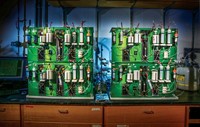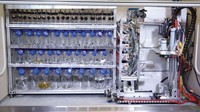Advertisement
Grab your lab coat. Let's get started
Welcome!
Welcome!
Create an account below to get 6 C&EN articles per month, receive newsletters and more - all free.
It seems this is your first time logging in online. Please enter the following information to continue.
As an ACS member you automatically get access to this site. All we need is few more details to create your reading experience.
Not you? Sign in with a different account.
Not you? Sign in with a different account.
ERROR 1
ERROR 1
ERROR 2
ERROR 2
ERROR 2
ERROR 2
ERROR 2
Password and Confirm password must match.
If you have an ACS member number, please enter it here so we can link this account to your membership. (optional)
ERROR 2
ACS values your privacy. By submitting your information, you are gaining access to C&EN and subscribing to our weekly newsletter. We use the information you provide to make your reading experience better, and we will never sell your data to third party members.
Synthesis
Flow process speeds up peptide synthesis
Fully automated machine is 10 to 100 times as fast as current batch-based methods
by Bethany Halford
March 6, 2017
| A version of this story appeared in
Volume 95, Issue 10
Nature makes amide bonds—the key linkages that string together amino acids in a polypeptide—like a knitting whiz. The ribosome in Escherichia coli bacteria, for example, can make eight amide bonds in a second. Chemists are novices by comparison, taking minutes to hours to form an amide bond in a flask.
These scientists are stepping it up, though; a group led by Bradley L. Pentelute of MIT has developed a fully automated flow approach to solid-phase peptide synthesis that can make an amide bond in seven seconds and assemble a peptide at a rate of 40 seconds per amino acid (Nat. Chem. Biol. 2017, DOI: 10.1038/nchembio.2318).
In solid-phase peptide synthesis, chemists grow a polypeptide chain on a polymer bead one amino acid at a time through cycles of amide-forming reactions. Pentelute and colleagues automated a 2014 manual flow system for such a process, resulting in an apparatus nicknamed “the Amidator.” It consists of a buffet of 50 solutions of different reagents, including natural and unnatural amino acids and chemical activators, hooked up to three pumps. The apparatus coordinates the reagents’ stoichiometry and controls when they are heated, all while the reagents are flowing along at 80 mL per minute.
The flow system is 10 to 100 times as fast as batch-based solid-phase peptide synthesis methods currently used, Pentelute says. If the Amidator worked nonstop for a year, it could create tens of thousands of peptides 30 amino acids long. “This really removes one of the bottlenecks to pushing chemical research forward,” Pentelute points out, “which is just the time it takes to get your hands on molecules.”





Join the conversation
Contact the reporter
Submit a Letter to the Editor for publication
Engage with us on Twitter